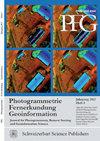Method Analysis for Collecting and Processing in-situ Hyperspectral Needle Reflectance Data for Monitoring Norway Spruce
Q Social Sciences
引用次数: 12
Abstract
Forest damage induced by bark beetle attacks can cause major economic losses in forest- ry. Hyperspectral remote sensing data and state of the art very high spatial resolution satellite data of- fer a great potential for assessing tree vitality. How- ever, a better understanding of the effects of vitality decrease and its impact on the spectral behaviour of needles is needed. Filling this knowledge gap can make a significant contribution to improve the in- terpretation of remote sensing data. However, it is still unclear which method for needle spectra col- lection is most suitable. In this work, two methods for spectral reflectance measurements of Norway spruce needles using portable spectroradiometers were tested and analysed: using a classical fore op- tic and a so-called contact probe. The spectral re- flectance data were evaluated with different statis- tical similarity measure techniques. Besides ana- lysing the measurements themselves, the methods were compared in terms of their practicality. Fur- thermore, the impact of storage on the reflection behaviour was investigated. The spectral measure- ments were performed in the field as well as in a laboratory and repeated three times during the 2013 growing season. Based on the obtained results we recommend measuring needle samples with the contact probe of portable spectroradiometers.挪威云杉原位高光谱针状反射数据采集与处理方法分析
树皮甲虫攻击引起的森林破坏会造成重大的经济损失,高光谱遥感数据和目前最先进的非常高空间分辨率卫星数据为评估树木活力提供了巨大的潜力。然而,需要更好地了解活力减少的影响及其对针叶光谱行为的影响。填补这一知识空白将对改善遥感数据的解译做出重大贡献。然而,目前尚不清楚哪一种针形光谱收集方法最合适。在这项工作中,测试和分析了两种使用便携式光谱辐射计测量挪威云杉针叶光谱反射率的方法:使用经典前光学和所谓的接触探针。利用不同的统计相似性度量技术对光谱反射率数据进行了评价。除了对测量结果本身进行分析外,还对这些方法的实用性进行了比较。此外,还研究了存储对反射特性的影响。光谱测量在野外和实验室进行,并在2013年生长季节重复三次。在此基础上,我们建议使用便携式光谱辐射计的接触式探针测量针样。
本文章由计算机程序翻译,如有差异,请以英文原文为准。
求助全文
约1分钟内获得全文
求助全文
来源期刊

Photogrammetrie Fernerkundung Geoinformation
REMOTE SENSING-IMAGING SCIENCE & PHOTOGRAPHIC TECHNOLOGY
CiteScore
1.36
自引率
0.00%
发文量
0
审稿时长
>12 weeks
 求助内容:
求助内容: 应助结果提醒方式:
应助结果提醒方式:


